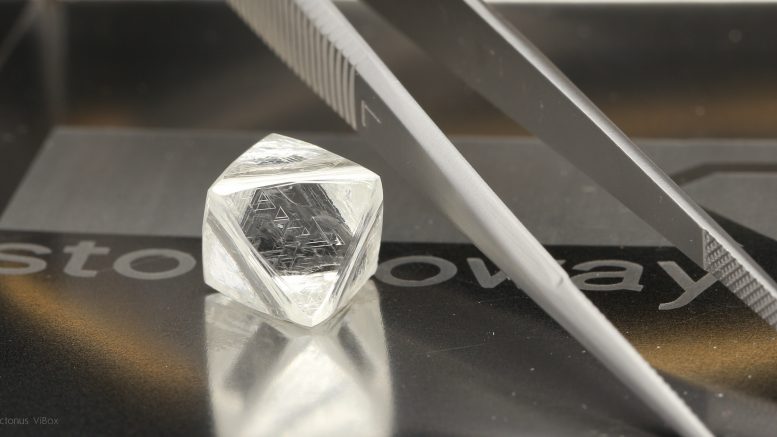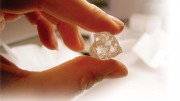In late 2016 and early 2017 the diamond market felt the effects of India’s demonetization, which saw 500-rupee and 1,000-rupee bills suddenly removed from the market last November. The move impacted India’s cottage cutting and polishing industry, a mainly cash business responsible for refining half of the world’s diamonds by volume or roughly 10% by value.
In an April interview with Northern Miner staff writer Salma Tarikh, Edward Sterck, Director of Equity Research, Metals and Mining at BMO Capital Markets, notes there are signs that the Indian currency reform, which started last November, is normalizing. The London-based analyst also explains why he expects higher rough prices following 2017, and shares his outlook on several diamond producers.
Diamonds in Canada: Rough diamond prices overall performed better in 2016 than they did in 2015. Where do you see prices heading this year and beyond?
Edward Sterck: This year we have a flat diamond price outlook, and part of that is just reflecting a little bit of uncertainty as to whether the Indian currency situation is really resolved or not.
Then for 2018 and ’19, we have got 6.5% per annum price inflation in our estimates and then flat thereafter. That just reflects my forecast of a little bit of mine supply increase this year as you have got Stornoway Diamond’s (TSX: SWY) Renard operation continuing to ramp up, Mountain Province Diamond (TSX: MPV; NASDAQ: MPVD) and De Beers’ Gahcho Kué operation completing its ramp up and then some production increases out of Dominion Diamond (TSX: DDC; NYSE: DDC) and Petra Diamonds (LSE: PDL).
But over the mid-to-longer term, we think diamond production has peaked, and at best we’d expect to see diamond production plateau at these levels. But depletion of the big operations in Botswana and Russia could result in production coming off slightly over the coming years.
DiC: Will the additional supply by the new producers impact the prices of smaller and lower-quality rough diamonds already hit by the Indian currency issue?
ES: Based on the pre-production independent diamond valuations, the overall product mix coming out of those mines is expected to be on average slightly better than the global average. So they won’t be contributing just to the lower end of the spectrum, it will be rather across the board with an average being slightly higher than the global average diamond prices.
For Renard and Gahcho Kué, Indian demonization has been an issue because with initial auctions for a new production centre, diamantaires tend to very cautious about the goods that come out. They don’t know how those goods are going to cut and polish, so they make their initial bids accordingly to reflect that uncertainty.
But the overall production increase from those operations isn’t really significant enough to exacerbate the Indian demonetization situation.
DiC: What would be the biggest near-term risks facing the diamond market?
ES: Indian demonetization is still there. I think it’s resolvable, but the timeframe in which that happens is uncertain. All I can say is that the indications are at the moment that it is being fixed.
Then I think it mainly comes down to the economic trajectory that the global economy is taking. So, if we are in the recovery part of the cycle, everything looks pretty good for diamonds going forward. And if people are actually still a bit nervous then they may postpone making jewelry purchases that they were otherwise planning to make, then that would be a negative.
DiC: Following an unsolicited US$1.1-billion bid from Washington Companies, Dominion Diamond recently formed a special committee to assess potential alternatives, including a possible sale of the company. You noted that the offer potentially underpriced the stock, which recently had fallen due to difficulties at the Ekati mine and the Indian demonetization. What would have been a fair price for the stock?
ES: The value really depends upon where we are in the cycle. Diamond stocks and valuation multiples applied are very, very cyclical. So if they are at bottom of the cycle, they might be priced around 0.4x NPV and at the top it could be 1.3x or even high as 1.5x NPV. The diamond cycle is linked to but somewhat independent of the global economic cycles. If we feel like we are coming out of the bottom of a cycle, then maybe higher multiples would be appropriate for a transaction. If we take a view that we are actually in the trough and should be there a little longer, than maybe lower multiples would be appropriate.
As things stand for me right now, with the caveat that I’m not an economist, it appears that we are probably in the recovery part of the cycle, maybe a more drawn out and protracted recovery than we have seen in previous cycles. Therefore maybe higher multiples somewhere around just about the middle of that range that I’ve given would be more appropriate. From an overall perspective, diamonds do tend to be quite a late-cycle commodity.
My target price for Dominion at the moment is $20. I think that is probably about as much as I’ll be prepared to be drawn on that right now.
DiC: Can you talk a bit about which companies may be interested in Dominion and the different alternatives Dominion might explore?
ES: There are various scenarios that one could come up with. Firstly, there could be some kind of merger with another diamond company. Is that necessarily a takeout situation that generates an immediate liquidity event for shareholders? Not particularly. That said, overall liquidity would probably be increased, so maybe that would be a positive.
When BHP was originally selling Ekati, press reports at the time suggested that private equity groups were interested. Perhaps it is reasonable to assume that they might be again now.
Then finally, one could potentially see Rio Tinto (NYSE: RIO; LSE: RIO) being interested. They are the operator of Diavik and maybe there are some synergies in combining the two operations. As things stand, Rio Tinto’s two diamond businesses — Diavik and Argyle — are both expected to end in some point in the early to mid-2020s. If Rio Tinto wanted to maintain its diamond business, then maybe there are opportunities to do that through combining Diavik and Ekati.
That said, I think there are some optical challenges to that. Principally, Rio Tinto is coming out of a period where it has been shedding assets. They have begun to talk about some M&A opportunities or M&A desires, which would be a better way to put it. But the entire focus to date so far has been on copper.
So for Rio Tinto to spend whatever the cost is to buy Dominion, which would probably be a bit more than a billion dollars, it might be optically a bit challenging to get across to the shareholders unless they can put forward a very tangible solid rationale.
DiC: Do you see Rio Tinto potentially selling its stake in Diavik and altogether exiting the diamond sector?
ES: It is quite possible. That is the other side of the equation rather than trying to keep it going, maybe, they would be prepared to sell. I think one of the challenges for Rio Tinto — bearing in mind that they ran a review of the diamond business a couple years ago — is that they have to have confidence that if they were to sell, whoever they sell to would be good stewards of the legacy.
DiC: You recently upgraded Lucara Diamond (TSX: LUC) to outperform while maintaining your target price at $3.50. You noted that the stock is expensive versus peers but that the potential for the company to sell its 1,109-carat Lesedi la Rona diamond and to recover other large stones calls for a premium. What’s the best avenue the company can pursue to get the most value for the diamond? When do you believe a potential sale will happen?
ES: That is one of the things that’s very difficult to judge — the timing of it. They tried to sell it via an auction with Sotheby’s but that didn’t work for whatever reason. I guess that there are other avenues that they could pursue: selling it as part of their regular special diamond tenders, or selling it directly to a diamantaire or private individual. Or maybe they could look to enter into some kind of beneficiation agreement, where they perhaps sell the rough for a little bit less than they would otherwise, but they retain an interest in the resale value of the polished goods.
DiC: You’re forecasting the diamond would go for US$75 million.
ES: Well, we have to pick a number. The reality is I’m not in the position to really look at the diamond and say this is how much it is worth. They sold a 813-carat diamond previously and that had a sale value at or above US$63 million.
DiC: Stornoway Diamond reached commercial production at its Renard mine last December. You currently have an outperform rating with a $1.25 target on the stock, which is trading around 82¢. Why is there a gap between your valuation and the trading price?
ES: The stock has taken a bit of a hit after the first sale. Firstly, they were impacted by Indian demonetization. In their first auction, a number of their goods were held back from sale because they felt the pricing offered wasn’t adequate and assuming the normalization of Indian demonetization, that they will get better prices in the future. We have to wait for the results of further auctions to see if that is the case or not.
The second factor is that they’ve been getting some breakage in the plant. Now that isn’t an unusual situation with a new diamond plant starting up. It isn’t unusual to have some processing issues in the plant of any commodity on startup.
Stornoway has brought in experts in minimizing diamond breakage and they have identified the areas in the plant where they feel that breakage is occurring. So, they have a remedial plan to try to resolve that situation. Now the potential for them to achieve that I think is pretty good. I would expect them to fix that situation and for that to ultimately result in higher realized diamond prices.
This story originally appeared in the June 2017 issue of Diamonds in Canada.




Be the first to comment on "Q&A: BMO’s Ed Sterck talks demonetization and diamond equities"